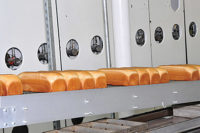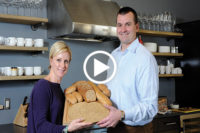It doesn’t feel like Snack Food & Wholesale Bakery is 100 years old, and that’s partly because we have changed names, formats, management, ownership and staffs several times throughout our long existence. The world is obviously completely different today than when we got started. To honor the past and look ahead to the future, we show you a glimpse of baking’s progress over the last century: The accomplishments; the discoveries; the evolution of products; and amusing stories. Selecting the important moments that took place to include in this synopsis wasn’t easy, because the industry is rich with hundreds and thousands of events and occurrences.
While we certainly can’t provide a comprehensive history of baking in the short space we have here, we wanted to provide a slice of the many highlights.
A leap year long ago
In 1912, a leap year just like 2012, the industrial age was flourishing. Improvements in transportation and the launch of refrigeration were changing the American diet. Though we still eat many of the same foods today that were favorites in the early part of the 20th century, food was prepared much differently back then. Commercial production of baker’s yeast had just begun. And since that time, bakers, scientists and yeast manufacturers have been trying to find and produce pure strains of yeast that meet exacting and specialized needs of the baking industry, according to www.dakotayeast.com.
At the time our magazine was getting started, the National Biscuit Co., or NabisCo, had an idea to sell a sandwich cookie product that included two chocolate disks with a creamy filling inside. The first Oreo cookie emerged, and looked surprisingly like it does today, with a slight difference in the design of the chocolate disks. The design didn’t change much until Nabisco began selling different versions of Oreos. Those came in 1975, when Double Stuf Oreos were born. How the name came about is a bit sketchy, however. Some say it was taken from the French word meaning “gold,” which was the main color on early packages. Others say it came from the Greek word for mountain, “oreo,” referring to the hill shape early test cookies were patterned after.
Regardless, the first sale of Oreo cookies went to a grocer in Hoboken named S. C. Thuesen. The sale took place before the big news of the year; the ship Titanic sailed and sank in April, before the first Opening Day at Fenway Park. Fast forward to a century later, and the brand’s present owner, Kraft Foods, is readying a centennial celebration for Oreos that looks ahead as well as back. The company is creating an edible way for consumers to help celebrate with a limited-edition variety called Birthday Cake Oreos.
“What we’ve really set out to do is something authentic for the brand, true to its roots, that’s fresh for today,” says John Ghingo, senior director for global biscuits, at the East Hanover, N.J., office of Kraft Foods. “We want to acknowledge what Oreo has been over the past 100 years,” he adds, “and recognize what it means in today’s world.”
Also in 1912, when incumbent president William Howard Taft was re-nominated, Otto F. Rohwedder of Davenport, Ia., was inventing the first bread loaf slicing machine. After many setbacks, Rohwedder came up with a prototype machine that sliced and wrapped bread to keep moisture inside. But it took years for this slicer to become accepted. Gas ovens were starting to replace wood- and coal-burning brick ovens and produced more even results, so that large automated baking units could increase productivity and throughput.















































